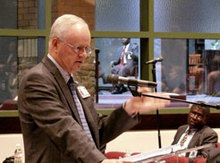October 16, 2007 Silver Spring, Maryland, United States …. [Elizabeth Lechleitner/ANN]
Church structure lacks merit unless it acts as an “instrument of mission,” members of the Seventh-day Adventist Church's Commission on Ministries, Services and Structures told the church's executive committee October 15.
The two-part report, presented by commission members, called for church officials to reevaluate the organization and operation of the Adventist Church. The commission proposed that church structure ought to adapt to cultural, political, legal and geographical influences and constraints.
Traditional church structure operates on four levels: local churches, conferences, unions and the world church's headquarters, or General Conference.
The report on flexibility implied that some aspects of that arrangement might be needlessly unwieldy. In some areas of the world, adhering to the church's traditional model of structure was deemed “unworkable and not financially viable” by the commission. In other cases, commission members decided to grant local leaders more leeway to decide which method of structure best fits their needs.
After voting to accept the commission's report, delegates also agreed to make allowance for multiple models of church structure, including changes in staffing and administrative services. Perhaps the most far-reaching adjustment is the acceptance of unions of churches — groups ranging from less than 2,000 members to more than 10,000 — as full-fledged administrative links between local churches and the General Conference.
The three-tiered structure was deemed an “acceptable” way to effectively use church resources and help advance the church's mission when traditional conference and unions cannot. A handful of the unions of churches now operate in Europe.
Previously, such unions have operated only under “exceptional” circumstances and were not a preferred model of church structure.
Lowell C. Cooper, a vice president of the world church and commission vice-chairman, said while church structure may appear hierarchical, such an assessment would be an “unfair caricature” because the church's levels of administration exist to collaborate and cooperate with one another, not exert command or control, he said.
With their recommendation to fully accept unions of churches, commission members quickly stressed that a union of churches would not be established before first proving its financial viability and ability to serve the needs of its members and promote the mission of the church.
Cooper, reading from the report, explained that the church's current structure is tethered to decisions made when the Adventist Church was small and based largely in North America. “Much has changed,” he said, adding that structure should be tweaked to accommodate the church's current international makeup.
“We've been waiting for a document like this for a long time,” said Atte Helminen, president of the church in Finland, where several small conferences are clustered within the country.
“It is important that those who are strong hear the voice of those who are not so strong,” said world church president and commission chair Jan Paulsen, explaining that many similar small countries could likewise benefit from becoming unions of churches.
Reinder Bruinsma, president of the church in The Netherlands, told delegates that unions of churches work especially well where the church is relatively small and where “too much energy would go into too many levels of administration serving too few people” if traditional structure was in place.
Vernon Parmenter, world church associate secretary, pointed out that many local levels of church administration complain that the church is “over-governed” and that they are left with very little money for local outreach and mission.
While financial concerns might influence church structure, the report warned that any arbitrary or rash structural changes — which might jeopardize the church's “global identity and unity” — would not be favorable.
Saustin Mfune, president of the church in Malawi, asked why, when only some church regions favor forming unions of churches, the issue had become a world church concern. He explained that in his church region, establishing a union of churches might end up funneling most resources and church employees to one area at the neglect of others.
Paulsen said that no group of churches would be obliged to become a union of churches, but that it was important for church headquarters to allow each church region to tailor its structure to best accomplish its mission. “The decision has to be made at each local level,” he said.
Commission leaders also stressed, however, that under the arrangement, groups of churches cannot independently declare themselves unions of churches. After thorough study, only the executive committee at world church headquarters can establish unions of churches, which will then officially be accepted at a General Conference session.
The commission, which includes representatives from church headquarters and local church regions, has met twice yearly since its launch during Annual Council 2005.
Find the commission's full report at its Web site.
Copyright (c) 2007 by Adventist News Network.

